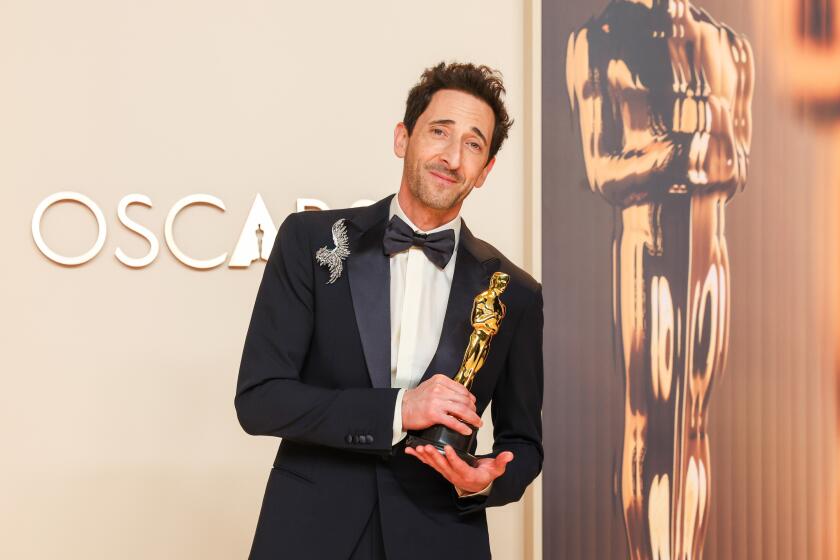Review: In a clear-eyed way, ‘The Price of Everything’ shows how the art world’s financial sausage is made
- Share via
If you are looking for 30 seconds of cinema that encapsulate the ways in which art can be distorted by the fire hose of money, then look no further than “The Price of Everything,” a new documentary from director Nathaniel Kahn.
In one scene late in the film, he places a laptop before Njideka Akunyili Crosby, a Los Angeles artist known for her collaged paintings of intimate domestic scenes. There he shows her footage of her 2012 work, “Drown,” hitting the auction block at Sotheby’s.
An unnamed buyer had acquired the painting, which depicts a tender embrace, at an exhibition several years prior. Now, the buyer was trying to see what it might get at auction. “Drown” sold for $1.1 million, well above its estimate of $300,000. Crosby won’t get a dime.
“A flipper bought it,” she says with a tight smile. “That’s what happened.”
“The Price of Everything” looks at how art and its market intersect — though not the market for ideas. What Kahn is looking at are the echelons in which art operates as an asset, where a painting fulfills a desire for power, prestige and financial one-upmanship. This is not a world of starving artists innovating new forms in their garrets. It’s auction house specialists, high-profile collectors and blue chip artists peddling merch.
Kahn, the director behind the wonderfully ruminative 2003 doc “My Architect,” about his late father, architect Louis Kahn, is now training his very candid lens on an art-financial system that encourages artists to crank out work that is profitable over thought-provoking.
“The Price of Everything” covers auctions and art fairs. It features artists who were hot, only to fall out of fashion. (Cue Larry Poons painting in a wintry barn-studio.) And it captures market darlings such as Jeff Koons, who manages to keep a straight face while explaining that it is he who makes his work — as he stands before a room full of assistants making his paintings: “Well, I am in a way physically doing it, but it’s physically through all these systems.”
Kahn also spends time with collectors such as Chicago mogul Stefan Edlis, who clinically outlines his collecting strategies: He maintains 200 works at a time, all mapped in a spreadsheet, and he prefers to trade old works for new ones, keeping the outlay low.
“To be an effective collector, deep down you have to be shallow,” he tells the camera. “You have to be a decorator.”
The issues the film raises — of the ways in which money has overtaken aspects of the art world — are not new. In 2008, the late critic Robert Hughes did a documentary on a similar theme titled “The Mona Lisa Curse.” In it, he lambasted the ways in which art “has just become a cruddy game for the self aggrandizement for the rich and the ignorant.”
But today’s auction prices — $400 million for a painting that might be by Leonardo da Vinci — have raised the stakes all around. Art dealers regularly poke around art schools in hopes of uncovering the next art star. Museums hand over their galleries to collectors for decades in hopes of securing donations — like the Art Institute of Chicago did for Edlis’ collection (which is shown in Kahn’s doc).
Kahn is a quiet filmmaker, and he gently prods his sources to go beyond the typical art world hyperbole of “gorgeous” and “wonderful.” And in a cool, clear-eyed way, he reveals how the $400-million sausage is made, how capitalism has turned art from idea into inventory.
As Edlis states of so much art buying: “A lot of them end up in storage.”
-------------
‘The Price of Everything’
Not rated
Running time: 1 hour, 38 minutes
Playing: Starts Oct. 26, Laemmle Music Hall, Beverly Hills; also on HBO, Nov. 12
Sign up for our weekly Essential Arts & Culture newsletter »
[email protected] | Twitter: @cmonstah
More to Read
The biggest entertainment stories
Get our big stories about Hollywood, film, television, music, arts, culture and more right in your inbox as soon as they publish.
You may occasionally receive promotional content from the Los Angeles Times.











